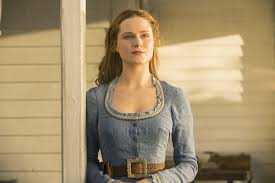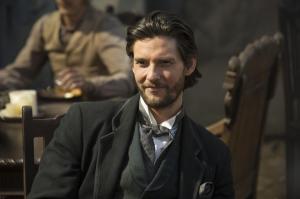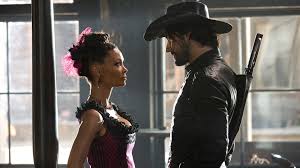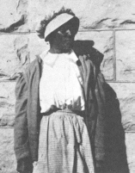Tags
19th Century America, Anthony Hopkins, Evan Rachel Wood, HBO, Rodrigo Santoro, Thandie Newton, The Wild West, Westworld
I’ve been watching Westworld, HBO’s new prestige series that they’re probably hoping will become their next Games of Thrones. So I figured I would take a break from my thoughts about Robin Hood to say what I’m thinking about this show. Back to Robin Hood next time.

For those who haven’t watched the series, it’s based on the 1973 Michael Crichton thriller of the same name. It focuses on an immersive playground, Westworld, in which android ‘hosts’ simulate the Wild West of the 1870s for the amusement of human ‘newcomers’ (the paying customers). The hosts are programmed to live out a set script that repeats itself every day unless a newcomer intervenes, in which case the hosts improvise appropriate reactions. Many of the hosts offer a ‘mission’, a unique storyline that provides adventure for the newcomers. The newcomers are allowed to do anything they want to the hosts. Some newcomers choose to be ‘white hats’ (signified literally with headgear), meaning that they are ‘good guys’ and deal with the hosts in pro-social ways, while other newcomers can be ‘black hats’, meaning that they may work with the various villainous hosts or engage in whatever mayhem they chose to direct against the hosts.
Unfortunately, some of the hosts are beginning to achieve sentience. Of these, the series focuses on Dolores (Evan Rachel Wood), the classic Western ingenue daughter of cattle-ranchers who are fated to be murdered unless a newcomer intervenes, and Maeve (Thandie Newton), the madame of the local brothel and saloon, who tends to get caught in the crossfire when violence breaks out there.

Wood as Dolores
Most of the rest of the cast are other hosts or the human staff who maintain the park, repair the hosts every night, and program the hosts with new stories and personality traits. But I want to talk about a third category of characters, the newcomers. Thus far the show has focused on three of them
- The mysterious Man in Black (Ed Harris) a long-time visitor who knows the park by heart and who is searching for a mysterious ‘next level’. He’s solidly in the Black Hat camp, slaughtering any host who gets in his way.
- Logan (Ben Barnes), another veteran newcomer who likes the park for the immoral hedonism that it allows him to indulge in.
- William (Jimmi Simpson), Logan’s brother-in-law and first-time newcomer. William almost instinctively gravitates toward a White Hat, despite Logan’s attempts to get him to indulge his more primitive urges. William decides to defend the confused Dolores once her awakening consciousness leads her away from her programmed story-line.
- We see a couple of other newcomers who don’t get names. In particular, there is what appears to be a husband and wife couple that turn up in a few episodes.

Barnes as Logan
The series makes no pretense of actually trying to recreate 1870s America. The park is clearly built around common clichés of the Western genre: gunfights, bandits, and whiskey flow in abundance. What interests me is the show’s missions.
Over the first several episodes we get to see some of the set storylines that hosts offer the newcomers. Mostly we see these from Logan and William’s point of view, but we also get to see the storylines that Dolores and Maeve fit into. The missions include
- Rescue Dolores when bandits murder her parents. Black Hats can join in with the bandits, and can rape and kill Dolores if they want. If no one intervenes, one of the bandits does that.
- Hector Escaton (Rodrigo Santoro) rides into town with a gang and shoots the place up to get what’s hidden in Maeve’s safe. Newcomers can kill his gang or, presumably, join Hector’s it.
- Hunt down various bandits and trouble-makers who are, of course, Wanted Dead or Alive.
- One minor host character offers a chance to find lost treasure.
- A hard-to-reach villain offers a mission to rob a group of American soldiers of a cargo of nitroglycerin they’re escorting.
What’s striking to me about this list are two things. First, it’s a very male-centric list of adventures. All of them are built around the opportunity to employ violence, either in pro-social (stop the bad guy) or anti-social (help or be the bad guy) ways. The only non-violent activity in Westworld seems to be having sex with a prostitute. Perhaps this is a reflection that the series creator decided to focus exclusively on male guests (Logan and William are obviously modeled on the two main characters in the 1973 version of the story). The husband and wife newcomers decide to pursue one of the bandits who needs capturing, but the wife either gets bored or finds the mission to0 physically uncomfortable; she rides back to town while her husband continues with the mission. There just don’t seem to be any missions that might appeal to women more than men.

Maeve and Hector
The female hosts seem to reinforce this sense of masculine urges as the point of the park. Dolores needs to be rescued from the bad guys, while the more worldly Maeve offers the opportunity for sex and seduction. Apart from these two, we only get to see two other recurring female hosts, the prostitute Clementine and the sharp-shooting bandit Armistice (Ingrid Bolso Berdal), a member of Hector’s gang with a brutal past. So all the female hosts apart from Armistice fall into very traditional feminine roles from the Western genre.
The show seems to acknowledge that the park is all about sex and violence in one episode when the park’s creator Dr. Ford (Anthony Hopkins) comments that originally there were an equal number of dark and ‘hopeful’ missions, but no one wanted to do the hopeful missions, so they were dropped in favor of darker ones.

Hopkins as Ford
But I don’t think the show is simply indulging in the standard HBO formula of violence and sex. Rather, I think what the show is (perhaps unintentionally) doing is demonstrating just how profoundly masculine our vision of the Wild West is. When we think of stories set in the Wild West, they are always stories of masculine violence: men seeking violent revenge on the bad guy who killed their family, men coming to town and violently protecting the defenseless residents from bandits or other villains, men drifting from town to town until they find the woman who gets them to stay and make a stand. With a few exceptions, the stories we (or rather Hollywood) choose to tell are overwhelmingly about (mostly white) men doing traditionally masculine things and saving the day.
Occasionally we get a movie about Calamity Jane or Annie Oakley, who are chiefly interesting because they act like men; they can shoot guns and ride horses well. We don’t tell a lot of stories about the female bandits like Pearl Hart or Belle Starr. Hollywood mostly bowdlerizes the rare story about Western madams or prostitutes like Poker Alice, making them into mostly sexless ‘hookers with hearts of gold’. Little House on the Prairie purported to tell the story of pioneer woman and prot0-libertarian crank Laura Ingalls Wilder, but presented her in a traditionally domestic role that rarely acknowledged the grueling physical hardships and social isolation that pioneer women struggled with. Hollywood doesn’t acknowledge the more deviant figures like the cross-dressing Charley Parkhurst, who lived as a man and drove stagecoaches for a living, or Cathay Williams, who served two years as a Buffalo Soldier under the name William Cathay after having fought in the Civil War. Black women like Williams are particularly invisible in our popular memories of the Old West.

Cathay Williams
Westworld, however, isn’t so much ignoring the highly sexist nature of Wild West mythology as meditating on it. I said earlier that the show isn’t just indulging the HBO formula of violence and sex, in part because there’s very little actual sex shown on-screen. Logan indulges himself with a couple of prostitutes and in a later episode he, William, and Dolores discover a massive orgy. That’s it so far over 5 episodes, when that would be about half an episode’s worth of sex on Game of Thrones. And while the hosts are frequently shown nude, as the park staff repair or reprogram them, the nudity acts not to sexualize them but to highlight their profound vulnerability to the staff’s manipulation.
With the sex considerably downplayed, the show is about violence. But it’s not just about letting us watch violence for titillation and shock. The show seems to be developing a critique about the effects of violence. Logan and William are offering us a story about the corrupting power of violence, while Dolores and Maeve both flash back to earlier ‘lives’ that ended in terrifying violence. They struggle to understand the effects of violence on their existence, a violence that matters even though they cannot clearly remember it. The original Westworld was a parable about the dangers of hedonism coming home to roost, and the new series seems determined to explore that in a far more intelligent and thought-provoking way than Game of Thrones ever has. Violence, the show seems to be saying, always has consequences, even in a place where violence isn’t supposed to have consequences.

I find it interesting how the show seems to throw in the occasional anachronism just to see if we are paying attention. So far that’s been with firearms, which I guess is in keeping with the show’s examination of violence. In the pilot episode the bandits who shoot up the town use pump action 12 gauge shotguns which wouldn’t exist till the 1890’s. Also in the episode before last week’s Ben Barnes’ character picked up a colt .38 revolver from one of the bandits he fought “upgrade”. That firearm wouldn’t exist till after the turn of the century.
I know it’s not historical but I’ve wondered if the show is making a commentary on the violent nature of online gaming culture and online MMORPGs. Ed Harris’ character reminds me of gamers I’ve read about who believe they alone can find the last easter egg or secret level in a game everyone has played over a thousand times.
LikeLiked by 1 person
Pump action fire arms actually date to the 1890s
https://en.m.wikipedia.org/wiki/Winchester_Model_1897
https://en.m.wikipedia.org/wiki/Winchester_rifle#Winchester_Model_1893.2F1897
As do various .38 cartridges and colt revolvers shooting them.
https://en.m.wikipedia.org/wiki/Colt_M1892
https://en.m.wikipedia.org/wiki/.38_Special
https://en.m.wikipedia.org/wiki/.38_Long_Colt
I didn’t look out for specific models. But there are post 1890s weapons directly derived from these that are almost identical visually. It’s not uncommon for film makers to substitute those or modern reproductions as they still fit. But are more common, reliable or safe.
For example you almost always see Chinese or Romanian weapons as “ak-47s” in American movies. As they’re more available here and cheaper.
So the level of technology is totally appropriate assuming an 1890s time frame. In fact the first practical semi automatic pistols were appearing at the time.
https://en.m.wikipedia.org/wiki/Semi-automatic_pistol
https://en.m.wikipedia.org/wiki/Borchardt_C-93
https://en.m.wikipedia.org/wiki/Mauser_C96
I think you’re right though there are deliberate anachronisms. The player pianos are often playing covers of modern rock and pop songs. And apparently the sound track features “western” versions and scoring of the same.
LikeLike
The piano is a nice, subtle metaphor for the androids’ lack of true autonomy. And I like the joke of the music.
LikeLike
I couldn’t stop smiling when I noticed that. Its a brilliant little subtle touch.
LikeLiked by 1 person
The park’s timeline seems to be the 1870s. There’s a passing reference to President Grant, and the rogue Confederate soldiers makes most sense then too. But perhaps they’re going for a timeless Wild West.
LikeLike
That’d place the fire arms at least 10 years too late. IIRC there weren’t even too many early developments for that style of revolver, pump actions, and what have before the 1880s. So even having more practical props take the place of early or hard to find weapons wouldn’t fly.
Classic Hollywood “timeless west” does seem to stick itself to with in a decades or so of the civil war. But that tends to go hand in hand with keeping props limited to lever action rifles, double barrel shotguns, early cartridge revolvers and gatling guns. And almost always just a single model of revolver, rifle or shot gun. Regardless of precise time frame. And that’s our sort of default “western” frame of mind. Come the 70’s with Spaghetti Westerns you start to see more varied time limes with more appropriate props/art design. The Dollars Trilogy being the most famous takes place between the 1860’s and 1870’s. You hit the 90’s and afterwards you start to see a lot more “late” Westerns. Westerns taking place between the 1880’s and 1910’s. Along with those sometimes set earlier, with cap and ball revolvers and breach or muzzle loading long guns. The thrust seems to be away from depicting a generic west and towards depicting a precise time period.
So I think what they’re going for is reference to those more modern 70’s onward westerns that broke from the white hat/black hat with a Peacemaker and Winchester fighting “Injuns” with bows and arrows mold. The later revival of westerns as a genre is sort of the original gritty re-imagining. Even as they worked over the old tropes. Embodying or deconstructing them to one extent or another. These moves took decided steps away from singing cowboys and John Wayne. Its appropriate as a reference point for the show. Though I’m not so sure how well it works as a hanging point for the park. The original movie came out as part of the 70’s end of the revisionist Western thing, and the central conceit of having a park based on Classic cowboy movies straight murder people is one of the major examples of how that all progressed over time.
This post brought to you by a *very* long paper I wrote about The Searchers back in film school.
LikeLiked by 1 person
I always enjoy seeing what other people see in this material that I don’t.
LikeLike
Oh I meant 60’s with spaghetti westerns up there. Typo.
LikeLike
And yes sadly women have not always fared well in Wild West cinema, here’s a couple of bad examples from modern cinema. The aforementioned Belle Starr showed up in the Walter Hill western THE LONG RIDERS (1980) where she mostly just hangs out talking tough and sleeping with David Carradine’s Cole Younger. Her biggest contribution to the plot is when she more or less incites a knife fight between Cole and her husband Sam Starr. Her later outlaw career doesn’t figure in the plot at all.
At least though Belle got to keep most of her dignity in tact, the same can’t be said of Calamity Jane played by Ellen Barkin in another Hill directed western WILD BILL (1995). From her very first scene in the movie Barkin’s Jane whines about how she never got to sleep with Bridges’ Hickock and never stops. That single desire becomes her whole character for the rest of the film’s 90+ minute running time.
What are your thoughts on the women of Clint Eastwood’s UNFORGIVEN (1992)?
LikeLike
Pingback: Robin Hood: The Battle on the Beach | An Historian Goes to the Movies
There is now an intriguing fan theory going around the net that the show is in fact showing us two different timelines in each episode. The Logan/William story according to the theory, is taking place 30 years ago, shortly after the park first opened. The storyline with the Man in Black (Ed Harris) and the park employees is taking the place in the “present” relatively speaking. The connecting character of Delores appears in both timelines cause of course she doesn’t age.
Here’s a video that best explains this theory:
LikeLike